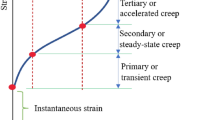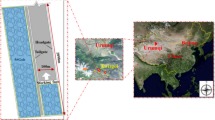Abstract
Miocene age coaly Tunçbilek basin (Kütahya/Turkey), which is named as “Tunçbilek Series”, is located at nearly the top level of the continental sequence. Lignite coal vein is bedded nearly at the base of the M2 unit consisting of claystone-marl interlayers. In the basin, the lignite coal vein with low dip angle (10‑30°) has been operated through open-pit and underground mining operations since the 1920s. At Y2-panel where the coal will be operated with the open-pit mining technique, firstly overburden material is removed by establishing benches, the coal bed is opened up, and then the coal is taken from the panel. Different panel geometries in the field are prepared for coal production. This research aims to predict further possible debris slides which may develop due to existing faults with high dip before excavation works in open-pit mine sites and to prevent land instabilities by changing the preplanned positions of the slope portions with the help of kinematic analyses. In order to safely design the overall slopes of the Y2 panel of Tunçbilek coal field, the relationships between the slopes and existing faults which may cause debris slides and those between the slopes and bedding planes and joints were kinematically investigated using the stereographic projection techniques before the excavations. Debris slides were determined in the slopes of A, C, H and L, wedge-type failures were determined in the slopes of B and C, and toppling failure was determined in the combined slope of E and F. The results obtained from these analyses suggest that the preplanned slope positions against probable slope instabilities should be changed to N5E/45NW for slope B, N36W/40SW for slope C, N80E/45SE for slope D, N20E/45SE for slopes E and F, N40W/45NE for slope G, N50W/45NE for slope H and N40W/45NE for slope L during the excavation phase.






Similar content being viewed by others
References
Barton N (1976) The shear strength of rock and rock joints. Int J Rock Mech Min Sci Geomech Abstr 13:255–279
Bostanci HT, Alemdag S, Gurocak Z, Gokceoglu C (2018) Combination of discontinuity characteristics and GIS for regional assessment of natural rock slopes in a mountainous area (NE Turkey). Catena 165:487–502
Crescenzo GD, Santo A (2005) Debris slides-rapid earth flows in the carbonate massifs of the Campania region (southern Italy): morphological and morphometric data for evaluating triggering susceptibility. Geomorphology 66:255–276
Cruden DM (1978) Discussion of G. Hocking’s paper “A method for distinguishing between single and double plane sliding of tetrahedral wedges”. Int J Rock Mech Min Sci Geomech Abstr 15, 217
Ergüler ZA, Karakuş H, Ediz İG, Şensöğüt C (2020) Assessment of design parameters and the slope stability analysis of weak clay-bearing rock masses and associated spoil piles at Tunçbilek basin. Arab J Geosci. https://doi.org/10.1007/s12517-019-5030-8
Ferrara V, Pappalardo G (2005) Kinematic analysis of rock falls in an urban area: the case of Castelmola hill near Taormina (Sicily, Italy). Geomorphology 66:373–383
Goodman RE (1976) Methods of geological engineering in discontinuous rocks. West Publishing, San Francisco
Goodman RE (1980) Introduction to rock mechanics. John Wiley, New York
Goodman RE, Bray JW (1976) Toppling of rock slopes. In: In: Rock engineering for foundations and slopes; Proceedings of a Specialty Conference, 2nd edn. Am. Soc. Civ. Eng, New York, pp 201–233
Gschwind S, Loew S, Wolter A (2019) Multi-stage structural and kinematic analysis of a retrogressive rock slope instability complex (Preonzo, Switzerland). Eng Geol 252:27–42
Gupta V, Tandon RS (2015) Kinematic rock fall hazard assessment along a transportation corridor in the Upper Alaknanda valley, Garhwal Himalaya, India. Bull Eng Geol Environ 74:315–326
Hoek E, Bray JW (1974) Rock slope engineering: institution of mining and metallurgy: 1st ed. Spon Press, Taylor and Francis Group, London
Hoek E, Bray JW (1981) Rock slope engineering. The Institution of Mining and Metallurgy, London
ISRM (International Society for Rock Mechanics) (2007) The complete ISRM suggested methods for rock characterization, testing and monitoring: 1974–2006. In: Ulusay R, Hudson JA (eds) Suggested methods prepared by the commission on testing methods, international society for rock mechanics, compilation arranged by the ISRM Turkish national group. Kozan Publishing House, Turkey
Johnson RM, Warburton J (2015) Sediment erosion dynamics of a gullied debris slide: a medium-term record. Catena 127:152–169
Kıncal C (2014) Application of two new stereographic projection techniques to slope stability problems. Int J Rock Mech Min Sci 66:136–150
Kıncal C, Koca MY (2009) A proposed method for drawing the great circle representing dip angle and strike changes. Environ Eng Geosci XV:145–165
Koca MY, Kıncal C (2004) Abandoned stone quarries in and around the Izmir city centre and their geo-environmental impacts—Turkey. Eng Geol 75:49–67
Koca MY, Kıncal C, Arslan AT, Yılmaz HR (2011) Anchor application in Karatepe andesite rock slope, Izmir-Türkiye. Int J Rock Mech Min Sci 48:245–258
Koleini M, Rooy JLV, Bumby A (2012) Slope stability modelling and landslide hazard zonation at the Seymareh dam and power plant project, west of Iran. Bull Eng Geol Environ 71:691–701
Mancarella D, Doglioni A, Simeone V (2012) On capillary barrier effects and debris slide triggering in unsaturated layered covers. Eng Geol 147-148:14–27
Markland JT (1972) A useful technique for estimating the stability of rock slopes when the rigid wedge sliding type of failure is expected. Imp Coll Rock Mech Res Rep 19:10
Norrich N, Wyllie D (1996) Rock slope stability analysis. In: Landslides: investigation and mitigation, Transportation Research Board Special Report, National Research Council, Washington, pp. 391–425
Onur AH, Konak G, Koca MY, Deliormanlı AH, Karakuş D, Kıncal C, Özdoğan MV, Öngen T, Turan G (2014) Report of the Tunçbilek (Kütahya) Yörgüç Y2 Panel Stripping Project submitted to Turkey Coal Enterprises Authority, West Lignites Management Directorate: Dokuz Eylül University, Engineering Faculty, Mining and Geological Engineering Departments; Technical Report, Izmir, 176p
Sarkar S, Roy A, Raha P (2016) Deterministic approach for susceptibility assessment of shallow debris slide in the Darjeeling Himalayas, India. Catena 142:36–46
Sasaki Y, Fujii A, Asai K (2000) Soil creep process and its role in debris slide generation – field measurements on the north side of Tsukuba Mountain in Japan. Eng Geol 56:163–183
Singh VK, Singh JK, Kumar A (2005) Geotechnical study for optimizing the slope design of a deep open-pit mine, India. Bull Eng Geol Environ 64:303–309
Solak KC, Tuncay E, Ulusay R (2017) An investigation on the mechanisms of instabilities and safe design of the south slope at a lignite pit (SW Turkey) based on a sensitivity approach. Bull Eng Geol Environ 76:1321–1341
Varnes DJ (1978) Slope movement types and processes. In special report 176: landslides: analysis and control. In: Schuster RL, Krizek RJ (eds) TRB. National Research Council, Washington, pp 12–33
Wang G, Sassa K, Fukuoka H (2003) Downslope volume enlargement of a debris slide-debris flow in the 1999 Hiroshima, Japan, rainstorm. Eng Geol 69:309–330
Yoon WS, Jeong UJ, Kim JH (2002) Kinematic analysis for sliding failure of multifaced rock slopes. Eng Geol 67(1–2):51–61
Zhou X, Chen J, Chen Y, Song S, Shil M, Zhan J (2017) Bayesian-based probabilistic kinematic analysis of discontinuity-controlled rock slope instabilities. Bull Eng Geol Environ 76:1249–1262
Acknowledgments
The corresponding author is grateful to the geological and mining engineers of West Lignites Management Directorate of Turkey Coal Enterprises Authority (TKI) established in the Tunçbilek (Kütahya-Turkey) for their support during field works. Critical reviews by editor, Dr. Zeynal Abiddin ERGÜLER and anonymous reviewer in an earlier version of this manuscript are gratefully acknowledged. I also thank Dr. Şeyda KINCAL for her help with language revision.
Funding
This study was supported by Turkey Coal Enterprises Authority through the slope stability project.
Author information
Authors and Affiliations
Corresponding author
Additional information
Responsible Editor: Zeynal Abiddin Erguler
Rights and permissions
About this article
Cite this article
Kıncal, C. Fault-controlling safe slope design procedure in an open-pit mine case study: Tunçbilek-Kütahya (Turkey) coal field. Arab J Geosci 14, 91 (2021). https://doi.org/10.1007/s12517-020-06343-1
Received:
Accepted:
Published:
DOI: https://doi.org/10.1007/s12517-020-06343-1




